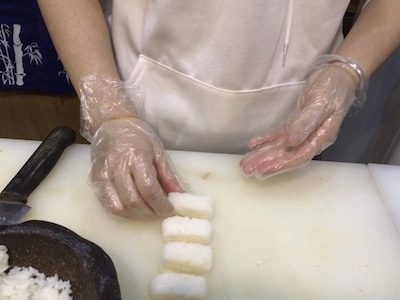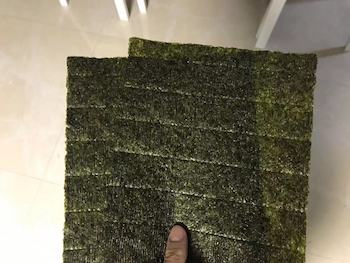We are reader supported. When you purchase through links on our site, we may earn an affiliate commission. Also, as an Amazon affiliate, we earn from qualifying purchases.

It happens with me quite often – I buy more sushi from the grocery store than I can possibly eat because of unbearable hunger pangs. The remaining pieces end up in the refrigerator with hopes to eat them the next morning but the dish loses its texture and taste. I am sure many of you can relate to the situation. So, what do you do to deal with that cold and bland breakfast?
Do you reheat sushi? I guess this is a good option to breathe back some life to your favorite nigiri or maki roll. You can revive your cold sushi by microwaving it for 30 seconds at 500 Watts. The raw fish may cook slightly but the rice will be back to room temperature and your sushi will taste better.
I know sushi traditionalists may not approve of the idea of reheating sushi because a raw delicacy is supposed to be eaten as it is, right? Furthermore, raw fish is served cold at restaurants too. However, let’s not forget that while the raw fish is cold, the sushi rice is always at room temperature when served fresh.
Analyzing The Effect Of Reheating On Sushi
The Japanese delicacy is not about just the fish, rice or other ingredients, but a blend of all these. It’s a perfect balance of vinegared sushi rice with raw fish and nori that together strike the right flavor and texture. So, if anything goes off, the harmony is disturbed.
If reheating can restore the texture even by 25% then it is certainly worth the effort. Let’s take a closer look at the different effects of reheating on sushi.
#. Raw Fish

There’s always a little risk associated with eating raw fish that had been sitting out for a long time after it was prepared. For this reason, I prefer eating sushi only at reputed restaurants where I can see the sushi chef preparing my food in front of my eyes. When making sushi at home, I always get sushi-grade fish and take good care for proper storage.
Having said that, there are times when we are too hungry and end up buying more grocery store or supermarket sushi than we can eat. I have often bought sushi and forgotten to eat them at all. You may even get a lot of leftovers if you bought more supplies than needed for a homemade sushi dinner.
Coming back to the question ‘do you reheat sushi’ and its impact on raw fish, I feel it works perfectly fine. When the chef prepares your sushi meal, his hands warm up the neta or fish part used in the recipe so you get hand-warmed fish which is not too frozen and not completely at room temperature either.
So, reheating at 500 Watts for just 30 seconds can give a similar effect to the fish. The fridge cold fish will soften down just a little bit and closely imitate that fresh feeling you get at a sushi restaurant.
Some people may consider heating it longer to cook the fish and rule out any possibility of bacterial infection. However, let’s not forget that it’s not just the fish you are heating but the sushi rice and nori which will turn soggy if microwaved for too long. If you are unsure of the raw fish or it feels off, it’s better to toss away the sushi.
#. Sushi Rice

The vinegared sushi rice is always served at room temperature at the restaurants or when you make your own sushi dinner. However, when you get it from a grocery store or supermarket, the sushi rice is usually cold and dry. Also, if you refrigerate leftover rice after a sushi dinner, it will be dry and bland.
One option is to take out the cold sushi from the fridge and let it sit outside for a few minutes until it reaches room temperature. However, the downside of this method is that the sushi rice will perspire and lose its texture. It will also taste bland.
Reheating for 30 seconds at 500 Watt in the microwave can have a magical effect on the sushi rice as it turns fluffy and slightly warm. It reaches room temperature without sitting outside and sweating. I agree that the sushi may not taste like fresh with this trick but it will at least be eatable than before.
#. Nori or seaweed
Nori is perhaps one of the most overlooked ingredients in sushi but it plays an important role in bringing out that authentic taste. It’s important to note that when westernized inside-out sushi was created, they did not completely let go of the seaweed.

The westerners did not like the appearance of the greenish-black nori cover on the outside, but that had nothing to do with the taste. As a result, the chef found a clever way to hide the nori so that it could still be incorporated into the dish without being visible.
Nori tastes crisp when it is fresh and is often toasted to make it crispier. I am sure you are aware of the difference in the taste and texture of nori between the restaurant sushi and store-bought one. If you are preparing sushi dinner at home, I recommend rolling one sushi at a time and consuming it immediately.
When left outside, the moisture from sushi rice and other ingredients like cucumber and avocado can seep into the Nori and turn it soggy. As a result, the grocery store-bought sushi usually has a soggy Nori on the outside.
Reheating your sushi will not bring about much difference to the nori except making it slightly warmer. Once it becomes soggy, you cannot make it crisp again, but if you don’t like it, you may just discard the bland nori and eat the inner content.
#. Vegetables
Sushi is not just raw fish, but there are a variety of vegetables that add lavour, color, and crunchiness to the dish. Some of the common examples of vegetables used in sushi are cucumber, avocado, bell peppers, sweet potato, asparagus, carrots, scallions, and so on.
Other than vegetables, sushi rolls may also contain tofu, shitake mushrooms, Japanese pickles, and various types of fruits. Storing sushi in the refrigerator may change the lavour and texture of the vegetables or fruits used in the dish. Avocados may oxidize so discard it completely.
Unfortunately, reheating does not do much to revive the taste or crispiness of the vegetables. Once they have become soggy, no amount of reheating can give back that same fresh lavour. However, the temperature may mellow down a bit and make the food more eatable.
Reheating Deep Fried Sushi Rolls
Crunchy and crispy, the deep-fried sushi rolls or the ones containing deep-fried ingredients such as the shrimp tempura rolls are to die for. However, when left outside for too long or worse when stored inside the refrigerator, the crunchy effect is lost and you are left with a fried soggy roll.
The advantage of eating grocery-bought or leftover fried sushi roll is that there is no risk of bacterial infection associated. The fish and sometimes other ingredients are deep-fried so you don’t have to worry about ingesting worms by mistake.
Do you reheat sushi that is deep-fried? You may, as this will bring back cold sushi to normal temperature, but it will do little to restore the crunchiness of your tempura roll. It can at best perk up the texture slightly so that it doesn’t taste as bad.
Tips To Avoid Having Sushi Leftovers
1. You know that sushi is a highly perishable item and refrigerated sushi does not taste as good the next day, so avoid buying too many sushi from the grocery store or supermarket. If you are super hungry and craving for sushi, buy a few sushi pieces to satisfy your cravings and get other foods to fill your stomach.
2. When making sushi dinner at home, try to get only as much raw fish as you can consume. Sushi-grade fish is expensive and there’s no point in risking your health by storing it in your home fridge. When cooking sushi rice, take the correct measurement so that you are not left with a lot of it after dinner.
3. If you throwing a sushi party, encourage your guests to roll their own sushi so everyone eats as much as they can without wasting anything. Instead of having lots of fish and veggies sliced beforehand, wait for all guests to arrive so that everyone can help in the preparation tasks.
Related Article: How Long Can Sushi Sit Out At A Party?
4. If you still have some leftovers, store them correctly by wrapping sushi rice in a damp cloth and keeping the sushi rolls in an air-sealed bag or air-tight container.
5. Make sure you consume the sushi stored in the refrigerator within 24 hours. I have written an article on whether sushi is safe to eat the next day and how it should be stored to delay deterioration.
A Useful Advice From A Japanese Friend
A Japanese friend once gave me good advice on what to do with cold sushi kept inside the refrigerator. She said that ideally, sushi rice should never go inside the refrigerator but for any reason, if you have to refrigerate your sushi roll or nigiri, eat it in this way:
Separate the fish and sushi rice part in case of nigiri sushi. In the case of sushi rolls, also separate other fillings. Cut the fish toppings of fillings into smaller pieces and cook with seasonings like shoyu or mirin. Throw away items like avocado that have probably oxidized by now. Also, discard the soggy nori.
Microwave or pan fry the sushi rice so that it’s no longer hard and regains a softer texture. Now mix everything together in a bowl, sprinkle some sesame seeds on the top and enjoy as warm and delicious chirashi sushi.
Related Questions
Can I bake sushi instead of microwaving
Yes, you may bake the sushi for 4 minutes on both sides to re-heat it. The raw fish will be cooked, and if the sushi has tempura then it will restore some crunchiness. The sushi rice may also get crispy but then it’s better than eating soggy rice.
How long can the sushi last in the refrigerator?
This will depend on when the sushi was prepared and how long it had been sitting out before putting it in the refrigerator. In general, I would say it’s better to consume your sushi at the earliest, and at most within 24 hours.
How soon should you refrigerate fresh sushi?
If you bought a grocery store or supermarket sushi, or you have leftovers from your home-cooked dinner, make sure you refrigerate everything within half an hour. The sooner the better in case of raw seafood. Cooked sushi can stay outside for longer but remember that the delicacy is meant to be eaten fresh and the longer you delay, the closer it gets to deterioration.
See Also: How Long Can Sushi Sit Out At A Party?


